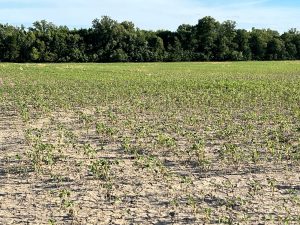The Heat is on Soybeans
By Dusty Sonnenberg, CCA, Ohio Field Leader, a project of the Ohio Soybean Council and soybean checkoff.

With near record-breaking hot temperatures all across the mid-west, questions are being asked about the potential impact on the soybean crop. In many areas of Ohio, the soybean crop was stressed early on by the cold weather and concerns of imbibitional chilling. More recently it has been stressed by too much water. Now concern comes in the form of hot and dry weather.
Alex Lindsey, Assistant Professor, Department of Horticulture and Crop Science is a plant physiologist. “From what I have read, soybean roots do enjoy warmer temperatures as long as they aren’t excessive to encourage growth and nodulation,” said Lindsey. “One paper tested temps up to 25C (77F) and saw optimal growth/nodulation, and another saw good nodulation at 28C (82F). I have also seen the range of 25-30C for optimum activity (77-86F). At temperatures above 33C (91F), nodulation started to be negatively affected and nodule formation decreased.
As long as soil temperatures don’t stay too high for too long, plants should be OK. It is also more challenging to increase wet soil temps than dry so the wet soils could help buffer/reduce the intense warming effect from reduced canopy closure at this point in the season. I would suggest growers look at local weather data if a 2” and 4” soil temperature sensor is available to see what soil temps are doing to help gauge the level of concern on this.
According to the National Ag Statistics Service (NASS) Ohio soil moisture for the week ending 6/19/22 was at 72% adequate and 21% surplus, (93% combined) with subsoil moisture at 68% adequate and 28% surplus (96% combined). In Ohio 74% of the soybeans have emerged, and 56% are rated as good to excellent.
The coming weeks will tell the story as soybean yield losses are most likely to occur when moisture stress occurs during germination and reproduction. There were germination concerns and some stand reduction due to excessive moisture and some crusting earlier in the spring. As the crop continues to develop, canopy closure is important to help regulate soil temperature by shading the soil and also helping conserve moisture by reducing soil evaporation.